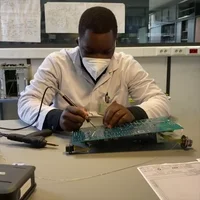Streamlining Cluster Restarts: Automating Consensus and Ensuring Data Integrity
 kaushik choudhury
kaushik choudhury
Introduction
Imagine a group of computer programs called validators that work together in a cluster. Sometimes, the entire cluster may stop working due to technical issues, and we need to restart it to get it running again. This process is called a "cluster restart."
Currently, when a cluster restart is needed, humans have to manually decide which block the validators should start from. However, this manual process can be prone to mistakes and can cause problems for the cluster.
To improve this, Mr.Wen Xu proposes a new protocol that automates the restart process. Here's how it works:
Silent Repair Phase: When the restart is initiated, the validators enter a special "silent repair phase" where they exchange information with each other using a communication method called gossip. They share their local status and the last block they voted for. This helps them to repair any missing blocks and reach a consensus on which block to start from

.
Repairing Blocks: During the silent repair phase, the validators repair blocks that may have been optimistically confirmed. Optimistically confirmed blocks are blocks that have received votes from the majority of the validators. Repairing these blocks ensures that the validators have the correct data.
Consensus on Restart Block: After repairing the blocks, each validator counts the votes for different forks (branches of the blockchain) and sends out information about the heaviest fork, which is the fork with the most votes. The goal is for the validators to agree on which block to restart from.
Agreement and Restart: If enough validators agree on the same block to restart from, the cluster proceeds with the restart. Otherwise, if there is no agreement, the validators print out information about the issue and stop the restart process.
This new protocol aims to automate the restart process and reduce the possibility of human errors. It allows the validators to reach a consensus on the restart block without human intervention. If everything goes well and an agreement is reached, the restart proceeds automatically. If there are any issues or disagreements, the validators stop and wait for further instructions from humans.

Benefits
The proposed protocol for automated cluster restarts brings several benefits and impacts developers in the following ways:
Reduced Human Intervention: With the automated restart process, developers no longer need to manually determine the highest optimistically confirmed block and make decisions during the restart. This reduces the possibility of human errors and makes the restart process more reliable.
Faster Recovery: The automated protocol allows for quicker recovery times during cluster outages. Instead of waiting for human intervention, the validators can autonomously exchange information, repair blocks, and reach consensus. This improves the overall recovery speed and reduces the downtime of the cluster.
Improved Cluster Reliability: By automating the restart process, the protocol increases the reliability of the cluster. Validators in restart can exchange information and repair missing blocks, ensuring they start from a consistent state. This helps maintain the integrity of optimistically confirmed blocks and reduces the likelihood of any issues or inconsistencies during the restart.
Simplified Workflow for Developers: The automated protocol simplifies the workflow for developers during cluster restarts. They no longer need to manually generate and download snapshots or coordinate the restart process. Instead, they can initiate the restart with the appropriate command-line argument, and the validators handle the rest, reaching consensus and restarting as necessary.
Potential for Future Automation: The proposed protocol sets the foundation for future automation of cluster recovery processes. As developers gain more experience and confidence in the automated restart approach, they can gradually explore automating other aspects to further improve cluster reliability and reduce the need for human intervention.
Restake Threshold:-
The RESTART_STAKE_THRESHOLD is an important parameter that determines the minimum stake participation required from validators during a cluster restart. The purpose of this threshold is to ensure that there are enough validators actively participating in the restart process to make decisions for the entire cluster.
Ideally, if everything goes perfectly, a restart could potentially be accomplished with just 2/3 of the total stake. This means that as long as the majority of the validators (more than 2/3) are actively involved, the restart can proceed smoothly.
However, in practical scenarios, validators may encounter issues such as hardware failures, network problems, or other abnormal behavior that could impact their participation. If a significant number of validators are unable to function properly or become unresponsive during a restart, it could hinder the decision-making process and potentially lead to a failed or inconsistent restart.
To account for these possibilities and ensure the highest chance of successful restart, the RESTART_STAKE_THRESHOLD is currently set at 80%. This means that validators with at least 80% of the total stake need to actively participate in the restart. This threshold provides a greater margin for handling any unexpected issues or failures among validators, reducing the risk of disruptions and increasing the overall reliability of the restart process.
By setting the RESTART_STAKE_THRESHOLD at 80%, the protocol aims to strike a balance between the need for sufficient validator participation and the potential challenges that can arise during a restart. It ensures that a significant majority of validators are actively involved in the decision-making process, increasing the likelihood of a successful and consistent restart for the entire cluster.
Author's Thought Process
The author's thought process is centered around addressing the limitations and challenges of the current cluster restart process, which heavily relies on human intervention. They acknowledge that the manual decision-making involved in determining the highest optimistically confirmed slot during a restart can be prone to mistakes. These mistakes can have severe consequences for the viability and integrity of the entire ecosystem.
To overcome these challenges, the author proposes automating the negotiation of the highest optimistically confirmed slot and the distribution of blocks on that fork. By automating this process, they aim to minimize the possibility of human errors during restarts, ultimately improving the reliability and efficiency of the ecosystem.
Automating the restart process not only reduces the burden on validator operators but also ensures that the validators themselves can autonomously reach a consensus on the restart block. This eliminates the need for constant human supervision during the restart. Instead, if anything goes wrong, the validators will halt and print debug information for operators to analyze. This allows operators to set up their own monitoring systems and intervene only when necessary, streamlining the overall restart process and freeing up human resources.
The author's thought process revolves around leveraging automation to enhance the restart process, minimize human errors, and create a more robust and self-reliant ecosystem. By reducing the reliance on human intervention and introducing automated consensus mechanisms, they aim to improve the efficiency, reliability, and overall health of the cluster restart process.
Reference's:-https://www.soldev.app/simd/0046-optimistic-cluster-restart-automation
Subscribe to my newsletter
Read articles from kaushik choudhury directly inside your inbox. Subscribe to the newsletter, and don't miss out.
Written by
